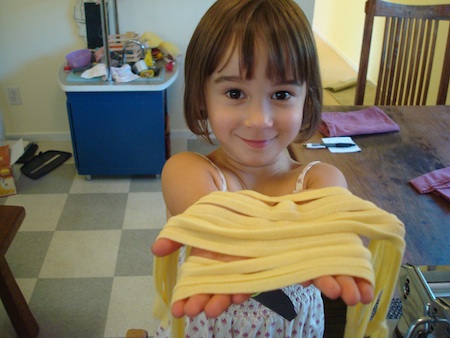
Pasta has a lot going for it. It has a high nutritional content, it is easy to prepare, has a long life, and is versatile.
That is why the world loves pasts. Actually, the world market for pasta is projected to reach 17.9 million tons by the year 2015, according to a new report from market researcher Global Industry Analysts, Inc. (GIA).
According to the report, “Pasta: A Global Strategic Business Report”, the United States and Europe accounting for 60 percent of the world’s pasta consumption. Per capita consumption of pasta varies among different regions worldwide with Japan consuming approximately 1.8 kilograms of pasta per year and Italians consuming 28.6 kilograms – or approximately 63 lbs – of pasta each year.
For Americans, pasta consumption has seen a gradual increase over the past several decades. In 1968, Americans pasta consumption was 6.2 pounds (2.8 kg) in 1981 it is 13 lbs (5.9 kg), and in 2008, it was 19.6 pounds 8.9 kg)!!!
Pasta is a complex carbohydrate, providing a steady supply of energy to the body. Made from semolina flour (which is ground from durum wheat), pasta is a good source of B vitamins, iron and niacin. This cholesterol-free food also has a low Glycemic Index (GI), which is essential to long-term health.
In kitchens throughout the U.S., only a handful of the nearly 500 pasta varieties found in Pastario, an Italian pasta encyclopedia (Eurgenio Medagliani and Fernanda Gosetti, 1997), are used.
Go beyond the spaghetti, penne and linguini shapes and explore the less familiar types such as maccheroni alla chiterra rom Abruzzi, bigoli from Venice, or paccheri from Naples.
Whichever pasta you choose, it is important to pair the pasta shape with the sauce, so that the two can complement and carry each other’s flavors. For instance, angel hair – or capellini – pasta are thin and delicate strands that are used with thin and delicate sauces. Conversely, using a ziti – the medium-sized tubular shaped pasta is ideal for chunky sauces or meat dishes. A good all-around pasta shape is rotini. Because of its twisted shape, it can hold meat, vegetables or cheese. It is perfect for anything from salads to baked casseroles, and even stir-fry.
For more about pasta shapes and their uses, visit theNational Pasta Association website.
A few popular myths about pasta that Family Eats can help clarify.
1. Adding olive oil to the cooking water in order to prevent the pasta from sticking together.:
If cooking good-quality pasta, there is no need. Lesser-quality pasta tends to stick together during cooking, therefore the addition of olive oil would help prevent it from sticking and clumping.
Also, as pointed out by Barilla USA, “A little bit of cooking water is usually reserved to help bind the sauce that is being used in the finished dish. By adding olive oil, the binding quality of the starches released in the water is offset by theslippery quality of the olive oil.”
2. How do I know when pasta is ready?:
The best way to test if the pasta is cooked is to cut it with a knife or fork. Or, you can simply bite into it. (There is no need to throw it against the wall). Cooked the authentic Italian way, pasta should be al dente, or slightly chewy with a small white dot at the core.
3. Should I rinse pasta after I cook it?:
As pasta cooks, the natural starches are released. These help bind the sauce and enable it to stick better to the pasta. So, if you are using the pasta immediately, don’t drain it. However, if you are preparing pasta salad, for example, drain and rinse the pasta in cold water to prevent it from overcooking.
Making Your Own Pasta
If you’re adventurous, why not make your own pasta. It is relatively easy to do, is very satisfying, and is inexpensive. Nothing is better than the flavor and texture of homemade pasta.
You can use either unbleached white flour or semolina flour to make pasta. Semonlina flour is a bit more difficult to work with, so a mix of the flours (1 part semolina to 4 parts unbleached flour) is a way for beginners to get the hang of it. Homemade pasta can be stored in the freezer for a couple of months.
For tips on making your own pasta, visit Easy Italian Cooking.
As part of the worldwide celebration, scientists, food authorities and pasta manufacturers will gather at the IV World Pasta Congress in Rio de Janeiro (Oct 26-26). During this two-day event, non-profit organizations, Oldways and the International Pasta Organization (IPO), will also organize a meeting of scientists about nutrition and healthy pasta meals.
“World Pasta Day is an opportunity to prepare the ultimate healthy pasta meal by getting creative in the kitchen, pairing pasta with wholesome partners such as olive oil, tomatoes, onions, vegetables, fish, beans, garlic, and a tablespoon or two of good cheese,” said Sara Baer-Sinnott, President, Oldways. “Pasta meals are the perfect delivery system for healthy foods for the entire family.”
Enjoy World Pasta Day, October 25th, and everyday.





